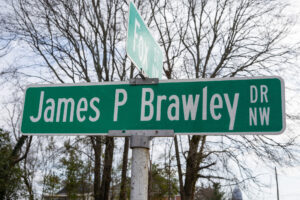Atlanta’s historic Westside is a living testament to the city’s rich past and enduring legacy. Throughout the community, streets and landmarks tell the stories of trailblazing leaders whose contributions shaped Atlanta—and the nation.
In honor of Black History Month, we are launching a blog series exploring the namesakes of four significant streets that run through the historic Westside. We begin with James P. Brawley Drive, a key corridor in the English Avenue and Vine City neighborhoods. Formerly known as Chestnut Street, this thoroughfare honors Dr. James P. Brawley—a visionary educator, university president, and tireless advocate for racial equity and higher learning.
The Legacy of James P. Brawley
Born on September 26, 1894, in Lockhart, Texas, James P. Brawley’s story is one of perseverance, dedication, and faith. After being adopted by his paternal aunt and uncle at the age of three, Brawley was raised in a Christian household that he credited with shaping both his personal and spiritual life. From attending a one-room elementary school to graduating with honors from Samuel Huston College, Brawley’s academic journey was marked by determination and excellence.
Brawley’s career in higher education began after earning his Bachelor of Arts degree and pursuing graduate studies at the University of Southern California, Northwestern University, and the University of Chicago. His passion for education and leadership brought him to Clark University (now Clark Atlanta University), where he became the head of the Department of Education and Religious Education in 1925. Over the next two decades, he rose through the ranks, eventually becoming president of Clark University in 1941—a position he held for 24 transformative years.
During his presidency, Brawley’s vision and leadership reshaped the institution and its role in the Atlanta University Center. He spearheaded the relocation of Clark University to its current site, initiated groundbreaking academic programs, and oversaw the expansion of the campus with new buildings, including an athletic field and a president’s residence. He also helped establish a development office and secured funding that left the university with a budget surplus and no debt by the time of his retirement.
Beyond his work at Clark, Brawley was a founding member of the United Negro College Fund (UNCF), a pivotal organization that has provided scholarships and financial support to Historically Black Colleges and Universities (HBCUs) for generations. His contributions extended into the Methodist Church, where he worked to eliminate racial segregation within its structures and championed social action.
James P. Brawley Drive NW: A Street Rich in History
James P. Brawley Drive NW runs through the historic English Avenue neighborhood, an area that has played a vital role in Atlanta’s cultural and civil rights history. English Avenue, known for its rich character and strong sense of community, was once a thriving hub of Black life and enterprise.
The renaming of Chestnut Street to James P. Brawley Drive NW is a recognition of the profound impact Dr. Brawley had on Atlanta’s Westside and the broader Black community. His contributions to education, his dedication to social justice, and his unwavering belief in the power of knowledge continue to resonate today.
Westside Future Fund’s Transformative Work on the Brawley Corridor
A vital thoroughfare through the English Avenue and Vine City neighborhoods, the Brawley corridor is at the heart of Westside Future Fund’s (WFF) commitment to equitable community revitalization. Through strategic development efforts, WFF has restored or rebuilt 27 single-family homes and developed 43 high-quality, affordable multifamily units—ensuring that legacy residents and individuals with deep community ties can continue to call the Westside home.
Alongside these housing efforts, WFF’s Anti-Displacement Tax Fund is protecting longtime homeowners on the corridor from rising property taxes, allowing them to remain in their homes and benefit from the neighborhood’s transformation.
Looking ahead, WFF is preparing to restore the historic Yellow Store, a once-thriving neighborhood landmark that, in the wake of disinvestment, became a hotspot for illegal activity. As part of a broader redevelopment strategy, the site is set to be revitalized into a dynamic mixed-use space, bringing new business and residential opportunities to the corridor.
Just across the street, St. Mark AME Church stands as another beacon of renewal. Once abandoned, the church has been reactivated as a vital community hub, thanks to the leadership of Reverend Winston Taylor. WFF has been honored to support this effort, reinforcing its commitment to fostering spaces that bring the community together.
Westside Future Fund’s work along the Brawley corridor is a critical piece of its mission to transform the historic Westside into a vibrant, mixed-income community. As the organization moves into Our Next Chapter—a pivotal capital campaign to fund its affordable housing goals through 2028—this work remains a testament to WFF’s dedication to inclusive, lasting progress.
Learn more about Our Next Chapter today.

